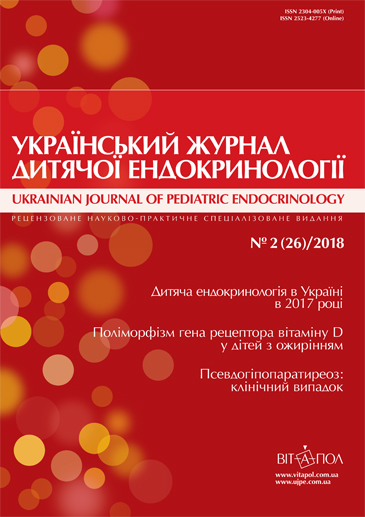Y-Хромосома в пацієнток із клінічним діагнозом синдрому Шерешевського—Тернера: огляд літератури та власне спостереження
DOI:
https://doi.org/10.30978/DE2018-2-48Ключові слова:
синдром Шерешевського—Тернера, діти, Y-хромосома, мозаїцизм, гонадобластома, діагностикаАнотація
Синдром Шерешевського—Тернера (СШТ) — це найпоширеніше генетичне порушення, пов’язане з аномалією Х-хромосоми. Повна відсутність у всіх клітинах однієї з Х-хромосом трапляється в 40—50 % випадків захворювання. У 5 % пацієнток із СШТ поряд із клітинами без генетичного матеріалу Х-хромосоми є клітинна лінія з каріотипом 46,ХY або лише частина Y-хромосоми, що клінічно може виявлятися вірилізацією і змішаною дисгенезією гонад. Рання ідентифікація генетичного матеріалу Y-хромосоми у пацієнток із СШТ має велике клінічне значення через підвищений ризик виникнення герміногенних пухлин.
У статті наведено дані про власне спостереження за дівчинкою із СШТ з рідкісним варіантом каріотипу, що містить генетичний матеріал Y-хромосоми.
Посилання
Barros BA, Moraes SG, Coeli FB et al. OCT4 immunohistochemistry may be necessary to identify the real risk of gonadal tumors in patients with Turner syndrome and Y chromosome sequences. Hum Reprod. 2011;26:3450-3455.
Beresheva AK, Yurov IYu, Kolotiy AD et al. A mosaic form of the Shereshevsky—Turner syndrome with a ring X chromosome in an 8-year-old girl: Use of molecular cytogenetic diagnostic techniques. Ros Vestn Perinatol Pediat. 2011;5:30-37.
Bianco B, Lipay M, Guedes A et al. SRY gene increases the risk of developing gonadoblastoma and/or nontumoral gonadal lesions in Turner syndrome. Int J Gynecol Pathol. 2009;28(2):197-202.
Bianco B, Lipay MV, Melaragno MI et al. Detection of hidden Y mosaicism in Turner’s syndrome: importance in the prevention of gonadoblastoma. J Pediatr Endocrinol Metab. 2006;19(9):1113-1117.
Bispo AV, Buregio-Frota P, Oliveira dos Santos L et al. Y chromosome in Turner syndrome: detection of hidden mosaicism and the report of a rare X;Y translocation case. Reproduction Fertility and Development. 2013;26(8):1176-1182.
Brant WO, Rajimwale A, Lovell MA et al. Gonadoblastoma and Turner syndrome. J Urol. 2006;(175):1858-1860.
Canto P, Kofman-Alfaro S, Jimenez AL et al. Gonadoblastoma in Turner syndrome patients with nonmosaic 45,X karyotype and Y chromosome sequences. Cancer Genet Cytogenet. 2004;150(1):70-72.
Cools M, Pleskacova J, Stoop H et al. Gonadal pathology and tumor risk in relation to clinical characteristics in patients with 45,X/46,XY mosaicism. J Clin Endocrinol Metab. 2011;96(7):1171-1180.
Delbridge ML, Longepied G, Depetris D et al. TSPY, the candidate gonadoblastoma gene on the human Y chromosome, has a widely expressed homologue on the X — implications for Y chromosome evolution. Chromosome Res. 2004;12(4):345-356.
de Marqui AB, da Silva-Grecco RL, Balarin MA. Prevalence of Y-chromosome sequences and gonadoblastoma in Turner syndrome. Rev Paul Pediatr. 2016;34(1):114-121.
Gravholt CH, Andersen NH, Conway GS et al. Clinical practice guidelines for the care of girls and women with Turner syndrome: proceedings from the 2016 Cincinnati International Turner Syndrome Meeting. European Journal of Endocrinology. 2017;177(3):1-70.
Gravholt CH, Fedder J, Naeraa RW, Muller J. Occurrence of gonadoblastoma in females with Turner syndrome and Y chromosome material: a population study. J Clin Endocrinol Metab. 2000;85:3199-3202.
Hook EB Warburton D. Turner syndrome revisited: review of new data supports the hypothesis that all viable 45,X cases are cryptic mosaics with a rescue cell line, implying an origin by mitotic loss. Human Genetics. 2014;133:417-424.
Hughes IA, Houk C, Ahmed SF, Lee PA, LWPES1/ESPE2 Consensus Group. Consensus Statement on Management of Intersex Disorders. Pediatrics. 2006;118(2):488-500.
Kanakatti Shankar R, Inge TH, Gutmark-Little I, Backeljauw PF. Oophorectomy versus salpingo-oophorectomy in Turner syndrome patients with Y-chromosome material: clinical experience and current practice patterns assessment. J Pediatr Surg. 2014;49:1585-1588.
Knauer-Fischer S, Besikoglu B, Inta I et al. Analyses of Gonadoblastoma Y (GBY)-locus and of Y centromere in Turner syndrome patients. Experimental and Clinical Endocrinology and Diabetes. 2015;123:61-65.
Kogan EA, Ushakova OE, Kur’yanova YuN et al. Morphological features of female gonadal dysgenesis and karyotype in patients with Shereshevsky—Turner syndrome. Archives of Obstetrics and Gynecology. 2016;3(2):87-91.
Lippe B, Westra SJ, Boechat MI. Ovarian function in Turner syndrome: recognizing the spectrum. Hibi I.; Takano K., editors. Basic and Clinical Approach to Turner syndrome. — Elsevier Science Publishers, 1993:117-122.
Oliveira RM, Verreschi IT, Lipay MV et al. Y chromosome in Turner syndrome: review of the literature. Sao Paulo Med J. 2009;127(6):373-378.
Paul G. McDonough, Sandra P.T. Clinical implications of overt and cryptic Y mosaicism in individuals with dysgenetic gonads.International Congress Series. 2006;1298:13-20.
Polityko AD, Khurs OM, Kulpanovich AI et al. Paternally derived der(7)t(Y;7)(p11.1 approximately 11.2;p22.3)dn in a mosaic case with Turner syndrome. Eur J Med Genet. 2009;52(4):207-210.
Rojek A, Obara-Moszynska M, Kolesinska Z et al. Molecular detection and incidence of Y chromosomal material in patients with Turner syndrome. Sexual Development. 2017;11:254-261.
Sallai A, Solyom J, Dobos M et al. Y-chromosome markers in Turner syndrome: screening of 130 patients. Journal of Endocrinological Investigation. 2010;33:222-227.
Sybert VP. Phenotypic effects of mosaicism for a 47,XXX cell line in Turner syndrome. J Med Genet. 2002;39:217-220.
Zelaya G, López Marti JM, Marino R et al. Gonadoblastoma in patients with Ullrich-Turner syndrome. Pediatr Dev Pathol. 2015;18(2):117-121.
Zhong Q, Layman LC. Genetic considerations in the patient with Turner syndrome-45,X with or without mosaicism. Fertil Steril. 2012;98(4):775-779.





